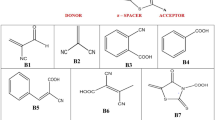Abstract
The Photophysical properties like ground state and excited state dipole moments, change in the dipole moment and fluorescence quantum yield of a boronic acid derivative 5-chloro-2-methoxy phenyl boronic acid (5CMPBA) are characterized. The study is carried out in various solvents at room temperature using absorption and steady-state fluorescence technique. The emission wavelength of 5CMPBA is quite sensitive to the polarity of solvents. With the increase in solvent polarity red shift or bathochromic shift of about 9 nm has been observed. The excited state and ground state dipole moments are estimated using solvatochromic shift method and effect of solvents on spectral properties of the molecule are investigated using Kamlet-Taft multiple linear regression approach. The changes in dipole moment (Δμ) are calculated both from solvatochromic shift method and microscopic solvent polarity parameter (E N T ), and the values are compared. The ground state dipole moment is also evaluated using quantum chemical calculations. The bathochromic shift of the emission spectra and the increase in the excited state dipole moment indicates π → π* transitions as well as the possibility of intramolecular charge transfer (ICT) character in the emitting singlet state of 5CMPBA. The relative quantum yield (Φ), radiative and non-radiative decay constants are calculated using single point method. It is found that the quantum yield of the molecule varies from 11 to 64 % with the change in the solvent polarity indicating the dependency of fluorescence nature on the solvent environment.











Similar content being viewed by others
References
Hall DG (2011) Applications of Boronic Acids in Chemical Biology and Medicinal Chemistry, Wiely Online Library
Cao Z, Nandhikonda P, Heagy MD (2009) Highly water-soluble monoboronic acid probes that show optical sensitivity to glucose based on 4-sulfo-1,8-naphthalic anhydride. J Org Chem 74(9):3544–3546
Badagu R, Lakowicz JR, Geddes CD (2005) Boronic acid fluorescent sensors for monosaccharide signaling based on the 6-methoxyquinolinium heterocyclic nucleus:progress toward noninvasive and continuous glucose monitoring. Bioorg Med Chem 13:113–119
Dai C, Cheng Y, Cui J, Wang B, Reactions C, Acids B (2010) Applications, issues, and potential solutions. Molecules 15:5768–5781
Lackowicz JR (1983) Principle of fluorescence spectroscopy. Plenum Press, New York
Melavanki RM, Patil HD, Umapathy S, Kadadevaramath JS (2012) Solvatochromic effect on the photophysical properties of two coumarins. J Fluoresc 22:137–144
Melavanki RM, Patil NR, BKapatkar S, Ayachit NH, Umapathy S, Thipperudrappa J, Nataraju AR (2011) Solvent effect on the spectroscopic properties of 6MAMC and 7MAMC. J Mol Liq 158:105–110
Muddapur GV, Patil NR, Patil SS, Melavanki RM, Kusanur RA (2014) Estimation of Ground and Excited State Dipole Moments of aryl Boronic acid Derivative by Solvatochromic Shift Method. J Fluoresc. Published online
Raghavendra UP, Basanagouda M, Melavanki RM, Fattepur RH, Thipperudrappa J (2015) Solvatochromic studies of biologically active iodinated 4-aryloxymethyl coumarins and estimation of dipole moments. J Molliq 202:9–16
Kamlet MJ, Abboud JLM, Abraham MH, Taft RW (1983) Linear solvation energy relationships.23. A comprehensive collection of solvatochromic parameters, π*, α and β, and some methods for simplifying the generalized solvatochromic equation. J Org Chem 48:2877–2887
Kamlet MJ, Abboud JLM, Taft RW (1981) An Examination of Linear Solvation Energy Relationships. Prog Phys Org Chem, John Wiley & Sons, New York 13: 630
Kamlet MJ, Abboud JLM, Taft RW (1977) The solvatochromic comparison method. 6. The π* scale of solvent polarities. J Am Chem Soc 99:6027–6035
(2004) Gaussian 03 program. Gaussian Inc, Wallingford
Schlegel HB (1982) Optimization of equilibrium geometries and transition structures. J Comput Chem 3:214–218
Williams ATR, Winfield SA, Miller JN (1983) Relative fluorescence quantum yields using a computer controlled luminescence spectrometer. Analyst 108:1067
Demas JN, Crosby GA (1971) Measurement of photoluminescence quantum yields. J Phy Chem 75:991–1024
Lippert E (1957) Z Eleckchem 61:962
Bakshiev NG (1964) Universal intermolecular interactions and their effect on the position of the electronic spectra of molecules in two component solutions. Opt Spektrosk 16:821–832
Chamma A, Viallet P (1970) Determination du moment dipolaire d’une molecule dans un etat excite singulet. CR Acad Sci Paris Ser C 270:1901–1904
Reichardt C (1988) Solvents and solvent effects in organic chemistry. VCH, Weinhwim
Bindhu CV, Harilal SS, Varier GK, Issac RC, Nampoori VPN, Vallabhan CPG (1996) Measurement of the absolute fluorescence quamtum yield of rhodamineB solution using a dual-beam thermal lens technique. J Phys D: Appl Phys 29:1074
Velapoldi RA, Tønnesen HH (2004) Corrected emission spectra and quantum yields for a series of fluorescent compounds in the visible spectral region. J Fluoresc 14(4):465–472
Turner GK (1964) Science 146:183
Bricks JB (1970) Photo physics of aromatic molecules. Wiley-Interscience, New York
Molander GA, Trice SLJ, Dreher SD (2010) Palladium-catalyzed, direct boronic acid synthesis from aryl chlorides: a simplified route to diverse boronate ester derivatives. J Am Chem Soc 132(50):17701–17703
Siddalingeswar B, Hanagodimath SM (2009) Estimation of first excited singlet-state dipole moments of aminoanthraquinones by solvatochromic method. Spectrachim Acta: A 72:490–495
Pang YH, Shung SM, Wong MS, Li ZH, Dong C (2005) Study on photophysical properties of intramolecular charge transfer (ICT) compound:4-(diphenylamino)biphenyl-4′-boronic acid. J Photochem Photobiol A: Chem 170:15–19
Acemioglu B, Arik M, Efeoglu H (2001) Solvent effect on the ground and excited state dipole moments of fluorescein. J Mol Struc (Theochem) 548:165–171
Compliance with Ethical Standards
Funding
This research work is not granted with any funds.
Conflict of Interest
Author R. M. Melavanki is thankful to Principal, M S Ramaiah Institute of Technology, Bangalore, India for his support and encouragement.
Author information
Authors and Affiliations
Corresponding author
Additional information
5-chloro-2-methoxyphenyl boronic acid (5CMPBA)
Rights and permissions
About this article
Cite this article
Geethanjali, H.S., Nagaraja, D. & Melavanki, R.M. Estimation of Dipole Moments and Quantum Yield of 5-chloro-2-methoxyphenyl Boronic Acid in Different Solvents Environment. J Fluoresc 25, 745–753 (2015). https://doi.org/10.1007/s10895-015-1561-x
Received:
Accepted:
Published:
Issue Date:
DOI: https://doi.org/10.1007/s10895-015-1561-x




